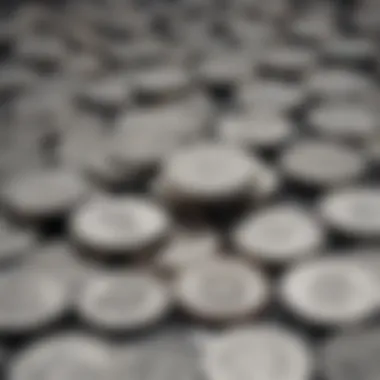Assessing the Market Value of Nine Ounces of Silver


Intro
Silver has captured the attention of investors and collectors alike for centuries. As a tangible asset, it offers both a hedge against inflation and a store of value. Nine ounces of silver may sound like a small amount, yet its worth can fluctuate significantly based on various market influences. In this article, we delve into the current market value of silver, examining what drives these prices and how one can effectively invest in this precious metal.
Gaining a firm grasp on the concept of investing in silver, particularly through the lens of nine ounces, isn't just about knowing the dollar amount; it involves understanding deeper market dynamics. This knowledge can empower individuals to make sound financial decisions, whether they're seasoned investors or novices eager to learn. Below, we explore foundational elements of silver investment to paint a clearer picture.
Understanding Silver as an Investment
When it comes to investing, silver often finds itself overshadowed by its glittering cousin, gold. However, to dismiss silver as a mere sidekick in the investment realm would be a significant oversight. Understanding silver as an investment means recognizing its multifaceted role not just as a precious metal, but also as a strategic asset with unique advantages and considerations. Investing in silver can diversify an individual's portfolio, serving as a hedge against economic downturns and inflation. Furthermore, silver's intrinsic properties, including its industrial demand, add another layer of complexity and opportunity for savvy investors.
In this section, we will dissect the importance of silver in modern markets, exploring both its historical significance and current trends that shape its investment landscape. The focus will be on how silver can be a reflection of economic health and a store of value, especially during turbulent financial times.
Historical Context of Silver Investment
To truly grasp the value of silver today, it is essential to look back at its historical context. Silver has been cherished for thousands of years, often regarded as a symbol of wealth and status. Its journey as a currency goes back to ancient civilizations, where it was used for trade and as a standard for value. For example, the ancient Egyptians utilized silver for jewelry and decor, while the Greeks minted coins from the precious metal as early as the 6th century BC.
Through the centuries, silver not only served as an alternative currency, but its price also followed a tumultuous path, reflecting broader economic trends. For instance, the discovery of vast silver deposits in the Americas during the Spanish conquests dramatically influenced its market value and produced a lasting economic impact. As such, understanding these historical fluctuations gives contemporary investors insight into potential future trends, as history has a curious way of repeating itself.
Current Trends in Silver Investment
In the present day, silver is witnessing a resurgence as an investment. As industries increasingly rely on silver for technological applications in electronics, solar panels, and medical devices, demand continues to rise. Furthermore, the recent global economic uncertainties have led many investors to seek refuge in silver as a tangible asset.
Recent data shows that silver often appears as a favored choice among millennials and eco-conscious investors due to its sustainability aspects. Another interesting trend is the rise of silver exchange-traded funds (ETFs), which offer a convenient avenue for individuals wanting to invest without the need to physically store the metal. This surge in popularity indicates a shifting perspective on silver's potential worth, marking it not just as an investment for wealth preservation, but also as a forward-thinking asset in a tech-driven market.
"Silver embodies an element of liquidity and physicality that reassures investors during times of financial unpredictability."
To sum it up, understanding silver's role as an investment requires not only a look at its storied past but also an acute awareness of its current relevance. As we delve deeper into the specifics of silver's market value, investors will be better equipped to grasp the true potential of nine ounces of this precious metal.
Calculating the Value of Nine Ounces of Silver
Understanding the calculations behind the value of silver isn't just a trivial pursuit; it’s essential for any investor or enthusiast seeking to navigate the sometimes murky waters of precious metal investments. Silver, often referred to as a safe haven in times of economic instability, requires a nuanced approach to accurately determine its worth. The value of nine ounces of silver can fluctuate widely based on a multitude of factors, from market sentiment to geopolitical events. Therefore, establishing a method to calculate this value is not only beneficial—it’s paramount.
Understanding Weight Specifications in Precious Metals
When discussing precious metals, the first step to valuation is understanding the weight specifications typically used in trading. Unlike common household items measured in grams or ounces, silver—and metals in general—often follows different scales. The troy ounce is the standard measure for precious metals, where one troy ounce equals approximately 31.1035 grams.
To put this into perspective, let’s break down how weight specifications come into play when valuing nine ounces of silver:
- Basic Calculation: Knowing that nine troy ounces roughly equals 280.2 grams helps in precise calculations.
- Market Measurement: Most exchanges and dealers will quote prices per troy ounce; hence knowing this unit is crucial for accurate value assessment.
- Physical Form: Whether you’re dealing with coins or bullion, the weight may vary slightly due to manufacturing processes and purity. For investors holding physical silver, any variances in weight can lead to differences in market value.
Understanding these specifications enhances one’s ability to make informed investment decisions.
Market Price Fluctuations and Their Impact


Market price fluctuations profoundly influence the value of silver, creating an environment akin to a wild rollercoaster ride for investors. Not only does the price of silver dramatically shift daily; it’s also subject to broader economic and geopolitical forces. For instance:
- Global Demand: As technology evolves, silver finds new applications, particularly in electronics and green technologies. Increased industrial demand can push prices higher.
- Supply Constraints: Mine output and geopolitical tensions in silver-rich regions, such as South America, can tighten supply and drive prices up.
- Economic Indicators: Economic reports such as unemployment rates or inflation data can set the stage for how traders react to silver prices, whether they are buying or selling.
"Monitoring these price movements is akin to keeping one's finger on the pulse of the economy—it's both thrilling and essential for sound investment strategy."
In summary, calculating the value of nine ounces of silver isn’t merely an exercise in mathematics; it involves a robust understanding of various elements from weight specifications to the unpredictable nature of market prices. Equipped with this knowledge, investors stand a better chance of successfully navigating their silver investments.
Market Factors Influencing Silver Prices
Understanding the market dynamics that dictate the price of silver is essential for anyone looking to invest. Various elements play pivotal roles in shaping these prices. By dissecting these factors, we'll provide clarity to investors and enthusiasts alike on what drives silver values, ultimately assisting in informed investment decisions.
Supply and Demand Dynamics
At its core, silver prices are profoundly influenced by the relationship between supply and demand. When we discuss supply, we are looking at the volume of silver available in the market for purchase, which can include newly mined silver, recycled content, and stockpiled reserves. Conversely, demand reflects how much people wish to obtain silver, which can come from various sectors including industry, jewelry, and investment.
- Industrial Demand: A significant portion of silver's demand is driven by its industrial applications. In photography, electronics, and solar panels, silver’s unique properties as a conductor are irreplaceable. As industries innovate and expand, demand can see a marked increase or decrease.
- Investment Demand: The rise of precious metals as a safe haven during economic uncertainty cannot be understated. Many investors flock to silver during times of market instability, driving prices upward.
- Market Sentiment: Fluctuations in investor sentiment can impact both supply and demand dramatically. Speculation can increase interest in silver, leading to higher prices, or conversely, a lack of faith in economic recovery may diminish demand.
This dynamic balance creates a continual dance of price fluctuation. If more silver is being sought than supplied, prices surge. However, if new mines come online or recycled silver floods the market, prices may drop.
"The price of silver is as much a reflection of human decision-making as it is of market fundamentals."
Geopolitical Factors
The geopolitical landscape can significantly impact silver prices. If a country is embroiled in conflict or political turmoil, the stability of its silver supply might be at risk. Surrounding factors such as sanctions, trade agreements, and wars lead to uncertainty in markets.
- Trade Agreements: Favorable agreements might enhance the flow of silver while unfavorable ones may restrict it. The dynamics between the U.S., China, and other nations often dictate how resources, including silver, move across borders.
- Political Stability: Countries rich in silver deposits may see price fluctuations based on their political climate. Instability can deter investment and lead to supply shortages, pushing prices up.
- Regulatory Changes: New legislations, whether they are environmental laws affecting mining operations or tariffs on imports, can create volatility in silver markets.
Economic Indicators
Lastly, macroeconomic factors also sway the price of silver. Indicators like inflation rates, currency strength, and economic growth projections can all have profound impacts on silver’s value.
- Inflation: Typically, when inflation rises, silver is viewed as a hedge, similar to gold. Investors may rush to acquire more silver, increasing demand and thus price.
- U.S. Dollar Strength: The value of the dollar plays a direct role in commodity pricing. Generally, a weaker dollar makes silver cheaper for investors using other currencies, thus boosting demand.
- Global Economic Growth: Economic growth can spur industrial demand for silver, enhancing its price. However, during economic downturns, investment demand may rise, leading to conflicting pressures on prices.
Overall, the intricate web of market factors that influence silver prices is vast. Understanding these elements can guide potential investors in making strategic decisions, whether to buy, hold, or sell their silver shares.
Historical Price Analysis of Silver
Understanding the past performance of silver is crucial for evaluating its viability as an investment. Analyzing historical price data helps identify trends, quantify market behavior, and assess risk for potential investors. Knowledge of long-term trends can highlight periods of growth and declines, guiding investment decisions. Moreover, historical analysis offers insights into how silver continues to react to market forces, whether it be demand spikes, geopolitical events, or shifts in economic conditions. This context is invaluable for those looking to invest wisely in silver.
Long-Term Price Trends
When considering long-term price trends, silver’s historical journey reveals significant fluctuations. For instance, during the late 1970s, silver prices soared due to a combination of rampant inflation and demand for safe-haven assets. However, by the 1980s, the market saw a dramatic collapse, as speculation fizzled out and the bubble burst. Price charts from this period are dotted with peaks and troughs charting economic events, such as the 2008 financial crisis, when investors flocked to precious metals as a hedge against market volatility. Understanding these long-term trends can illuminate possible future movements, giving investors a sense of timing in their buying decisions.


Price Changes in Recent Years
More recently, silver's price has been on a rollercoaster. From about 2011, when prices hit an all-time high of roughly $49 per ounce, the market witnessed a steady decline, dragging below $15 per ounce during the downturn. The years 2020 and 2021 sparked renewed interest as pandemic-induced uncertainties made silver, alongside gold, a go-to for risk-averse investors, driving prices back up. Monitoring these shifts in recent years—especially in response to global events—shows how sensitive the silver market is to external variables. Investors must be aware of these modern price changes when assessing the potential of their silver holdings.
Comparative Analysis with Gold
When comparing silver to gold, the two metals often coexist in investors' strategies, yet their value trajectories can be quite distinct. Gold has traditionally been viewed as the ultimate safe haven, particularly during economic instability. Conversely, silver tends to have higher volatility. For example, during the height of the COVID-19 pandemic, while gold prices surged, silver's ascent, although significant, was not as pronounced. The gold-to-silver ratio, which measures how many ounces of silver one ounce of gold can buy, oscillates widely, providing a useful metric for evaluating their relation. For instance, during market lows, a higher ratio may suggest silver is underpriced in comparison to gold, potentially creating investment opportunities. Investors should carefully weigh silver’s performance against gold to make informed decisions about their portfolios.
"Investors must treat silver with both caution and opportunity; understanding its historical price performance is key to navigating the future."
Investing in silver is not just about buying at the right price—it's about a deeper understanding of its historical context, recent trends, and comparative performances within the precious metals market. This insight is critical in creating a robust investment strategy.
Investing in Silver: Practical Considerations
Investing in silver is not just about buying a shiny metal; it’s a deep dive into a world where fluctuations can heavily impact not only portfolios but also financial futures. With economic instability creeping in from various corners, many individuals are revisiting silver as a go-to hedge against inflation and uncertainty. This section helps clarify significant components, benefits, and key considerations when contemplating silver investments.
Different Forms of Silver Investments
While many think of silver as a simple commodity, it can take various forms, each holding unique attributes and risks. Understanding these forms can guide investors in making informed choices.
Physical Silver
The allure of holding silver in your hands is undeniable. Physical silver, in forms like coins and bars, provides a tangible asset that can be stored away in a safe or vault. This form is appealing due to its
intrinsic value. Unlike stocks or ETFs, you can feel the weight and see the brilliance of the metal firsthand. However, some investors might find disadvantages in the need for secure storage and potential theft risks. Ultimately, for those who value control and direct ownership, physical silver remains a popular choice.
Key Characteristics:
- Intrinsic value
- Tangibility
Pros:
- Provides a sense of security
- No counterparty risk
Cons:
- Must consider safe storage
- Potential for liquidity issues
Silver ETFs
Exchange-Traded Funds (ETFs) focused on silver can be a less hands-on approach for those wary of storage concerns. Silver ETFs, such as the iShares Silver Trust, allow investors to gain exposure to silver prices without needing physical possession. For traders, the liquidity factor is vital, and these financial instruments provide a favorable option for quick transactions.
Key Characteristics:
- Stocks that track silver prices
- Easily tradable in the market
Pros:


- Convenient and easy to buy/sell
- Doesn’t require physical storage
Cons:
- Subject to management fees
- No ownership of the metal itself
Mining Stocks
Investing in mining stocks presents another angle. Companies like First Majestic Silver Corp represent an investment in the underlying production of silver, rather than the metal itself. This form can be quite volatile, often subject to broader market dynamics. For investors willing to ride the ebbs and flows, it can represent a higher risk but potentially higher rewards. Additionally, companies might offer dividends, adding extra appeal compared to other forms of silver investing.
Key Characteristics:
- Stocks of companies that mine silver
- Potential for dividends
Pros:
- Possible higher returns through company performance
- Diversification across mining sectors
Cons:
- Market factors can heavily influence stock prices
- Operational risks related to mining operations
Assessing Investment Risks
As with any investment, assessing risks in the silver market is crucial. Several variables come into play, including market fluctuations, geopolitical events, and economic conditions. Educating oneself about these risks can help investors navigate the often-cloudy waters of investing in silver.
"Risk management isn’t just about minimizing potential losses; it’s about being informed and ready for what might come down the pipeline."
Investors should weigh the advantages and potential drawbacks of their chosen investment forms carefully, as this knowledge will greatly enhance their ability to make sound financial decisions.
Ending
The conclusion serves as the cornerstone of our exploration into the value of nine ounces of silver. It's not just the end of the article; rather, it distills the critical lessons we've gleaned throughout our analysis. Investors and silver enthusiasts must grasp the nuances of what makes silver a unique asset.
In today's dynamic market environment, understanding silver's worth transcends mere financial engagement. There’s a rich historical context to consider, alongside current trends and practical investment strategies.
Summary of Key Insights
- Historical Perspective: Silver has been a significant part of human history, often viewed as a store of value akin to gold. Its longstanding presence as a medium of exchange speaks volumes about its reliability. Understanding how it has fared against inflation and economic downturns allows investors to navigate their choices with informed caution.
- Market Dynamics: The intricate dance of supply and demand cannot be overstated. Supply chains, mining outputs, and geopolitical issues heavily influence price points. An awareness of these factors means one can better anticipate shifts in the market.
- Investment Forms: Whether investing in physical silver bars, Silver ETFs, or mining stocks, each route carries its own risks and rewards. For instance, while physical silver can provide a tangible asset, investing in ETFs can offer liquidity and ease of transaction.
"Investing in silver requires both understanding and patience, highlighting the age-old adage that good things come to those who wait."
- Risk Assessment: A comprehensive grasp of what risks are involved is crucial. Silver's price can be volatile, and awareness of external economic factors is necessary for sound investment decisions.
Future Outlook for Silver Investments
Looking ahead, the future of silver as an investment asset appears promising, albeit intertwined with uncertainties shaped by global economic conditions.
- Emerging Technologies: As industries shift towards renewable energy and technological advancements, silver's role in solar panels and electronics may lead to increased demand. This presents a ripe opportunity for investors who keep their ear to the ground regarding technological trends.
- Economic Recovery: Post-pandemic recovery can signal a bullish trend in silver prices. As economies reopen and industries rev back up, market demand might rise significantly, impacting silver's valuation positively.
- Diversification Strategies: Silver can still be a crucial component in a diversified investment portfolio. Balancing it with other assets like stocks or bonds mitigates risk and enhances overall returns. Investors should ponder their financial landscape and fit silver either as a hedge against inflation or as a speculative play.















